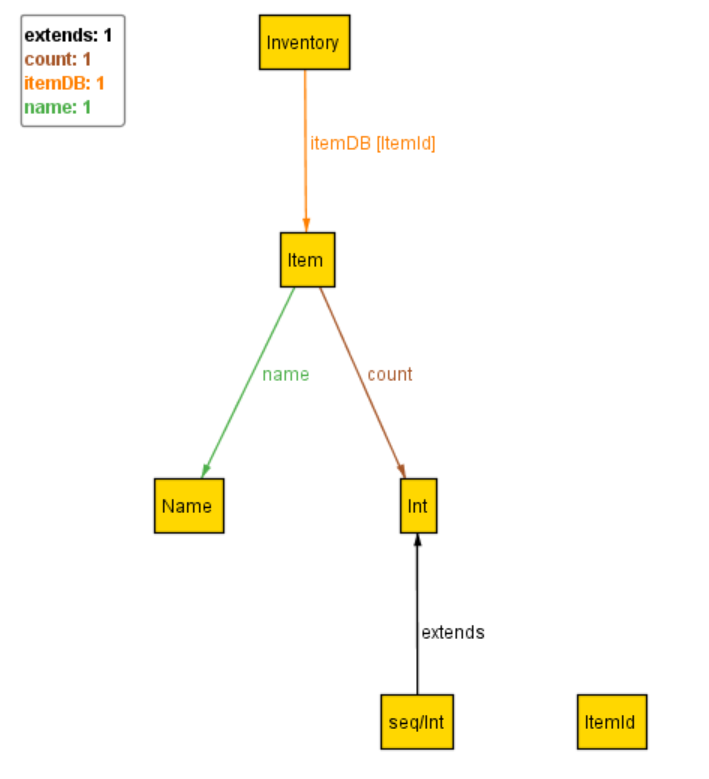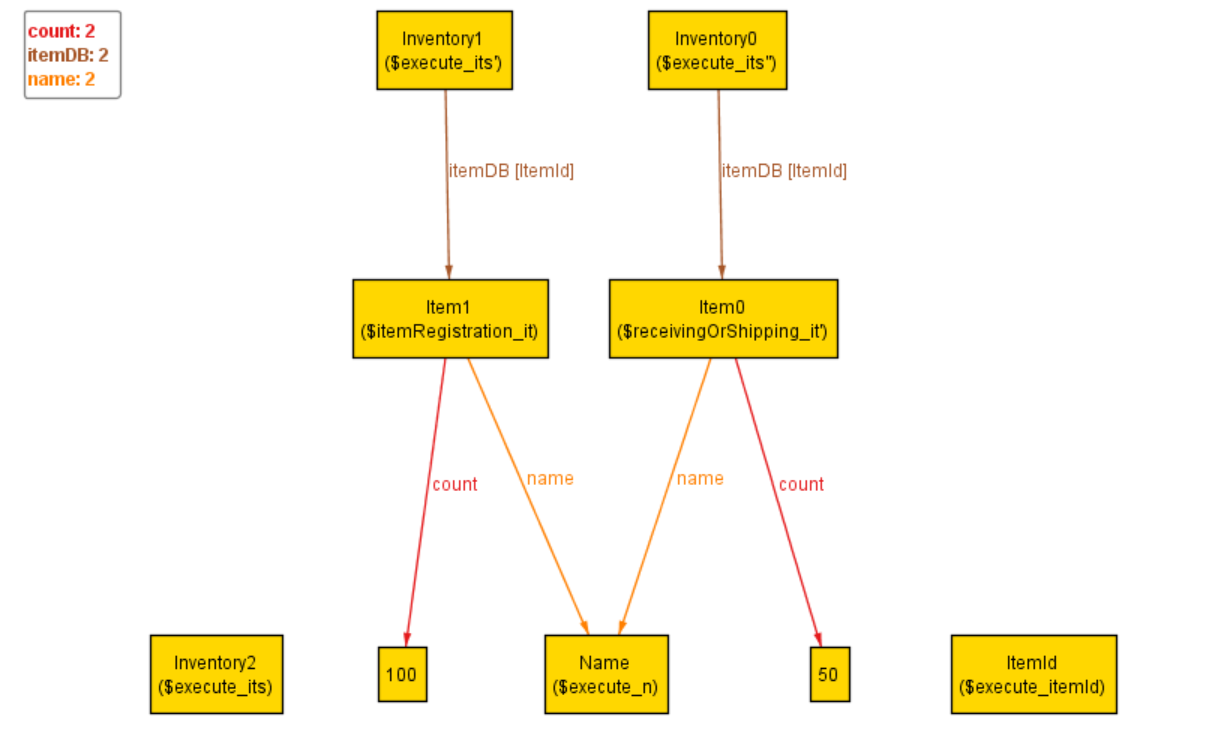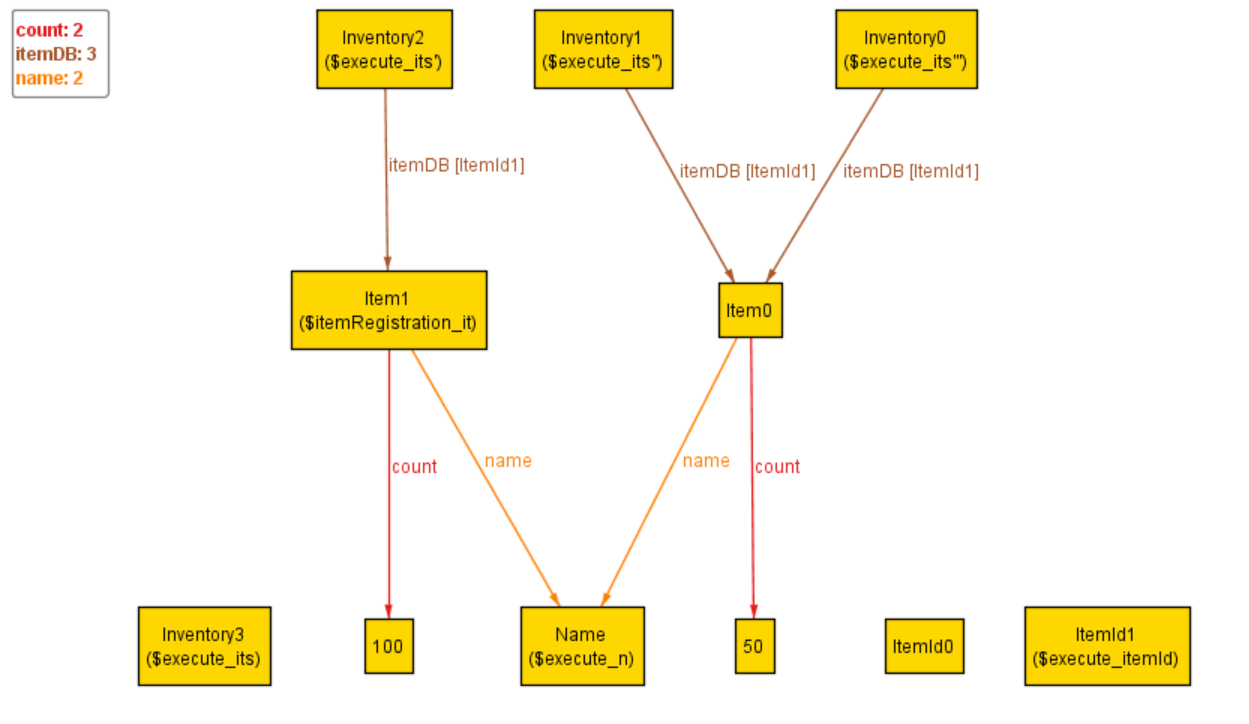
ここでは,InventoryManagement の Alloy による仕様記述に関する課題に取り組んでいただきます.
以下に Alloy で記述された InventoryManagement のモデルを示します.こちらを適宜参照しながらモデルの理解を行ってください.
sig
Alloy では,商品id の集合を ItemId ,商品名の集合を Name ,
商品全体を保管する倉庫の集合を Inventory ,商品の集合を Item で表します.
以下のモデルでは ItemId ,Name ,Inventory ,Item の順番にこれらの集合を宣言しています.
Inventory には,ItemId から Item への対応関係がitemDB フィールドとして定義されています.
Item の宣言では,商品名を表す name が Name のインスタンスとして,
在庫数を表す count が Int
pred
最初の述語として記述されている init は,Inventory の
インスタンスである its が初期化されていることを示しています.
次の itemRegistration は,itemId に対応する商品を登録する前の Inventory のインスタンス its と,
登録した後のインスタンス its' の関係を述語として定義しています.
ここで quantity は初期数量,n は商品名を示しています.
receivingOrShipping ではitemId で登録されている商品に対して入荷か出荷を行った際の操作前の Inventory のインスタンス its と,
操作後のインスタンス its' の関係を述語として定義しています.
ここで quantity が正の値のときは入荷,負の値のときは出荷を表しています.
最後の execute では,init ,itemRegistraction ,receivingOrShipping を
この順で呼び出す操作を定義しています.
runexecute を呼び出して仮想実行を行います.
この実行の際に,
sig ItemId, Name{}sig Inventory { itemDB: ItemIdlone ->lone Item }sig Item { name : Name, count:Int }pred init[its: Inventory] {no its.itemDB }pred itemRegistration[its, its': Inventory, itemId: ItemId, quantity:Int , n: Name] {some it: Item | {no itemId2: ItemId | its.itemDB[itemId2] = it its'.itemDB = its.itemDB + itemId -> it it.name = n it.count = quantity } }pred receivingOrShipping[its, its': Inventory, itemId: ItemId, quantity:Int ] {some it': Item | {no itemId2: ItemId | its.itemDB[itemId2] = it' its'.itemDB = its.itemDB ++ itemId -> it' it'.name = its.itemDB[itemId].name it'.count = plus[its.itemDB[itemId].count, quantity] } }pred execute[] {some disj its, its', its'': Inventory, itemId: ItemId, n: Name | { init[its] itemRegistration[its, its', itemId,100 , n] receivingOrShipping[its', its'', itemId, -50 ] } }run executefor 2 but3 Inventory,8 Int
先ほどの InventoryManagement のモデルの構造を,Alloy の可視化ツールを使用して可視化したものを以下の図に示します.

この図がモデルの実行に依らない,モデルそのものが持つ構造を表していることに注意して下さい.
Inventory が,ItemId のインスタンスを Item のインスタンスに対応させる itemDB という
フィールドを持っており,Item が Name のインスタンスを参照する name フィールドと,
count フィールドを持っていることがわかります.
ここでは,InventoryManagement モデルの仮想実行について説明します.この仮想実行で用いるテストケースは次の通りです.
このテストケースはモデル中の execute 述語で実装されています.
execute の仮想実行を可視化したものを以下に示します.

左下にある Inventory2($execute_its) は execute 述語中の変数 its で参照される Inventory のインスタンスであり,init 述語を満たしているため,
まだ何の商品(Item)も登録されていない状態になっています.
次に,1番上の段の左にある Inventory1($execute_its') は変数 its' で参照されるインスタンスで,
its で参照されるインスタンスに対して,itemId で参照される Item のインスタンスを初期数量100個で登録したインスタンスになっています.
Inventory1 の右にあるInventory0($execute_its'')は少し複雑です.
まず,Inventory1 において,ItemId で参照される Item のインスタンスは Item1 です.このインスタンスに対して50個出荷した後の Item のインスタンスは Item0 になります.
ここで Item0 の在庫数が50個に減少していることに注意して下さい.
ItemId で参照される Item のインスタンスが Item1 から Item0 に変わるので,Inventory のインスタンスも Inventory1 から Inventory0 に変わります.
本課題ではまず,上記にて説明を行った InventoryManagement の仕様に,ある機能を追加した仕様を考えます.
その仕様のモデルと,仮想実行を可視化した以下の図を見ていただいた上で,2つの設問にお答えいただきます.
設問にお答えいただく際は,必ず設問1,設問2の順番でご解答下さい.以下の図と同じものが設問のページにも記載されているのでこのまま設問のページに飛んでいただいてもかまいません.
sig ItemId, Name{}sig Inventory { itemDB: ItemIdlone ->lone Item }sig Item { name : Name, count:Int }pred init[its: Inventory] {no its.itemDB }pred itemRegistration[its, its': Inventory, itemId: ItemId, quantity:Int , n: Name] {some it: Item | {no itemId2: ItemId | its.itemDB[itemId2] = it its'.itemDB = its.itemDB + itemId -> it it.name = n it.count = quantity } }pred shippingOrReceiving[its, its': Inventory, itemId: ItemId, quantity:Int ] { plus[its.itemDB[itemId].count, quantity] <0 implies {all itemId': ItemId | its'.itemDB[itemId'] = its.itemDB[itemId'] }else {some it': Item | {no itemId2: ItemId | its.itemDB[itemId2] = it' its'.itemDB = its.itemDB ++ itemId -> it' it'.name = its.itemDB[itemId].name it'.count = plus[its.itemDB[itemId].count, quantity] } } }pred execute[] {some disj its, its', its'', its''': Inventory, itemId: ItemId, n: Name | { init[its] itemRegistration[its, its', itemId,100 , n] shippingOrReceiving[its', its'', itemId, -50 ] shippingOrReceiving[its'', its''', itemId, -75 ] } }run executefor 2 but 4 Inventory,8 Int

課題アンケート (別タブが開きます)
課題終了後の評価アンケート (別タブが開きます)